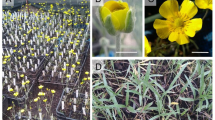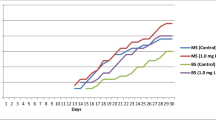Abstract
An efficient protocol for direct and indirect shoot regeneration and proliferation from bulb scales of Shirui lily (Lilium mackliniae Sealy), an endangered Asiatic lily species endemic to the Shirui hill peak, Manipur, India, has been developed. Bulb scales were isolated from mature bulbs and cultured on Murashige and Skoog (MS) basal medium supplemented with different concentrations of 6-benzylaminopurine (BAP), kinetin (KIN), or thidiazuron (TDZ). For direct shoot regeneration from bulb scale explants, 0.5 mg L−1 BAP yielded the highest shoot induction (3.5 shoots per scale; a 96.7% response). For indirect de novo organogenesis, optimum callus induction was achieved with 2.0 mg L−1 2,4-dichlorophenoxyacetic acid (2,4-D), and shoot organogenesis was higher (16.2) when subcultured onto 0.5 mg L−1 BAP medium. Multiple shoot regeneration and pseudo-bulb formation protocols were assessed; the highest shoot proliferation (10.1) occurred with 0.5 mg L−1 BAP and 1.0 mg L−1 gibberellic acid (GA3). Rooting response was 96% with 0.5 mg L−1 1-naphthalene acetic acid (NAA), with multiple roots per shootlet. Plantlet survival was increased to 92.5% during the hardening-off process by using hydroponics with Hoagland’s solution in a mist chamber. Clonal fidelity was assessed through random amplified polymorphic DNA (RAPD) analysis comparing the mother plant and regenerated plantlets. After confirming genetic uniformity, the pseudo-bulblets with four to six leaves and three to four roots were successfully established at the Shirui hills peak. This in vitro regeneration and ex vitro conservation approach could be helpful to save this rare endangered species in a sustainable way.




Similar content being viewed by others
References
Aguettaz P, Paffen A, Delvallee I, Van der Linde P, De Klerk GJ (1990) The development of dormancy in bulblets of Lilium speciosum generated in vitro: 1. The effects of culture conditions. Plant Cell Tissue Organ Cult 22:167–172
Azadi P, Khosh-Khui M (2007) Micropropagation of Lilium ledebourii (baker) Boiss as affected by plant growth regulator, sucrose concentration, harvesting season and cold treatments. Electron J Biotechnol 10:582-591. https://doi.org/10.2225/vol10-issue4-fulltext-7
Bacchetta L, Remotti PC, Bernardini C, Saccardo F (2003) Adventitious shoot regeneration from leaf explants and stem nodes of Lilium. Plant Cell Tissue Organ Cult 74:37-44. https://doi.org/10.1023/A:1023315321931
Bakhshaie M, Khosravi S, Azadi P, Bagheri H, van Tuyl JM (2016) Biotechnological advances in Lilium. Plant Cell Rep 35:1799-1826
Chen C, Chang-Tesrn C, Yu-Ching T, Wei-Chin C (2000) A tissue culture protocol for propagation of a rare plant, Lilium speciosum Thunb var gloriosoides Baker. Bot Bull Acad Sin 41:139-142
Deb CR, Imchen T (2010) An efficient in vitro hardening technique of tissue culture raised plants. Biotechnology 9:79-83. https://doi.org/10.3923/biotech.2010.79.83
Duncan D (1955) Multiple range and multiple F tests. Biometrics 11:1-42. https://doi.org/10.2307/3001478
Godo T, Kobayashi K, Tagami T, Matsui K, Kida T (1998) In vitro propagation utilizing suspension cultures of meristematic nodular cell clumps and chromosome stability of Lilium x formolongi hort. Sci Hortic (Amsterdam) 72:193-202. https://doi.org/10.1016/S0304-4238(97)00126-X
Ho C-W, Jian W, T, Lai H, C (2006) Plant regeneration via somatic embryogenesis from suspension cell cultures of Lilium×formolongi hort. Using a bioreactor system. In Vitro Cell Dev Biol - Plant 42:240-246. https://doi.org/10.1079/IVP2006756
Hoagland D, Arnon DI (1938) The water culture method for growing plants without soil. Calif Agric Exp Stn Bull 347:1-39. https://doi.org/10.1017/CBO9781107415324.004
Kanchanapoom K, Ponpiboon T, Wirakiat W, Kanchanapoom K (2011) Regeneration of lily (Lilium longiflorum ‘Easter lily’) by callus derived from leaf explants cultured in vitro. Sci Asia 37:373-376
Karalija E, Parić A, Muratović E (2013) Biochemical status of in vitro regenerated Lilium bosniacum and Lilium cattaniae plantlets. Cent Eur J Biol 8:912-920. https://doi.org/10.2478/s11535-013-0213-x
Kataki SK (1987) Lilium mackliniae Sealy. In: Nayar MP, ARK S (eds) Red Data Book of Indian Plants, Vol.1. Botanical Survey of India, Kolkata, p 187
Kedra M, Bach A (2005) Morphogenesis of Lilium martagon L. explants in callus culture. Acta Biol Cracov Ser Bot 47:65-73
Liu J, Zhang J, Xu B, Jia C, Zhang J, Tan G, Jin Z (2011) Regeneration and production of transgenic Lilium longiflorum via Agrobacterium tumefaciens. In Vitro Cell Dev Biol - Plant 47:348-356. https://doi.org/10.1007/s11627-010-9336-1
McRae EA (1998) Lilies: a guide for growers and collectors. Timber Press, Oregon
Mori S, Adachi Y, Horimoto S, Suzuki S, Nakano M (2005) Callus formation and plant regeneration in various Lilium species and cultivars. In Vitro Cell Dev Biol - Plant 41:783-788
Murashige T, Skoog F (1962) A revised medium for rapid growth and bioassays with tobacco tissue cultures. Physiol Plant 15:473-497
Nhut DT (1998) Micropropagation of lily (Lilium longiflorum) via in vitro stem node and pseudo-bulblet culture. Plant Cell Rep 17:913-916. https://doi.org/10.1007/s002990050508
Nhut DT (2003) The control of in vitro direct main stem formation of Lilium longiflorum derived from receptacle culture, and rapid propagation by using in vitro stem nodes. Plant Growth Regul 40:179-184. https://doi.org/10.1023/A:1024263803684
Nhut DT, Hanh NTM, Tuan PQ, Nguyet LTM, Tram NTH, Chinh NC, Nguyen NH, Vinh DN (2006) Liquid culture as a positive condition to induce and enhance quality and quantity of somatic embryogenesis of Lilium longiflorum. Sci Hortic (Amsterdam) 110:93-97. https://doi.org/10.1016/j.scienta.2006.05.015
Park SY, Kim YW, Moon HK, Murthy HN, Choi YH, Cho HM (2008) Micropropagation of Salix pseudolasiogyne from nodal explants. Plant Cell Tissue Organ Cult 93:341-346. https://doi.org/10.1007/s11240-008-9362-4
Pérez-Tornero O, Burgos L (2000) Different media requirements for micropropagation of apricot cultivars. Plant Cell Tissue Organ Cult 63:133-141. https://doi.org/10.1023/A:1006430718024
Sharma V, Belwal N, Kamal B, Dobriyal AK, Jadon VS (2016) Assessment of genetic fidelity of in vitro raised plants in Swertia chirayita through ISSR, RAPD analysis and peroxidase profiling during organogenesis. Braz Arch Biol Technol 59. https://doi.org/10.1590/1678-4324-2016160389
Skoric M, Zivkovic S, Savic J, Siler B, Sabovljevic A, Todorovic S, Grubisic D (2012) Efficient one-step tissue culture protocol for propagation of endemic plant, Lilium martagon var. African J Biotechnol 11:1862-1867. https://doi.org/10.5897/AJB11.2076
Stanisic M, Raspor M, Ninkovic S, Milosevic S, Calic D, Bohanec B, Trifunovic M, Petric M, Subotic A, Jevremovic S (2015) Clonal fidelity of Iris sibirica plants regenerated by somatic embryogenesis and organogenesis in leaf-base culture-RAPD and flow cytometer analyses. South African J Bot 96:42-52. https://doi.org/10.1016/j.sajb.2014.10.014
Taha LS, Sayed SS, Farahat MM, El-Sayed IM (2018) In vitro culture and bulblets induction of Asiatic hybrid lily ‘red alert’. J Biol Sci 18:84-91. https://doi.org/10.3923/jbs.2018.84.91
Tang YP, Liu XQ, Wahiti Gituru R, Chen LQ (2010) Callus induction and plant regeneration from in vitro cultured leaves, petioles and scales of Lilium leucanthum (baker) baker. Biotechnol Biotechnol Equip 24:2071-2076
Tribulato A, Remotti PC, Löffler HJM, Van Tuyl JM (1997) Somatic embryogenesis and plant regeneration in Lilium longiflorum Thunb. Plant Cell Rep 17:113-118. https://doi.org/10.1007/s002990050362
Van Tuyl JM, Van Diën MP, Van Creij MGM, Van Kleinwee TCM, Franken J, Bino RJ (1991) Application of in vitro pollination, ovary culture, ovule culture and embryo rescue for overcoming incongruity barriers in interspecific Lilium crosses. Plant Sci 74:115-126. https://doi.org/10.1016/0168-9452(91)90262-7
Varshney A, Lakshmikumaran M, Srivastava PS, Dhawan V (2001) Establishment of genetic fidelity of in vitro-raised Lilium bulblets through RAPD markers. In Vitro Cell Dev Biol - Plant 37:227-231. https://doi.org/10.1007/s11627-001-0040-z
Wang J, Huang L, Bao MZ, Liu GF (2009) Production of interspecific hybrids between Lilium longiflorum and L. lophophorum var. linearifolium via ovule culture at early stage. Euphytica 167:45-55. https://doi.org/10.1007/s10681-008-9859-2
Wawrosc C, Malla PR, Kopp B (2001) Clonal propagation of Lilium nepalense D.Don, a threatened medicinal plant of Nepal. Plant Cell Rep 20:285-288. https://doi.org/10.1007/s002990100322
Wickremesinhe ERM, Holcomb EJ, Arteca RN (1994) A practical method for the production of flowering Easter lilies from callus cultures. Sci Hortic (Amsterdam) 60:143-152. https://doi.org/10.1016/0304-4238(94)90069-8
Xi M, Sun L, Qiu S, Liu J, Xu J, Shi J (2012) In vitro mutagenesis and identification of mutants via ISSR in lily (Lilium longiflorum). Plant Cell Rep 31:1043-1051. https://doi.org/10.1007/s00299-011-1222-8
Acknowledgments
The authors are thankful to the Director and Joint Director of ICAR Research Complex for NEH Region for the infrastructure facilities. The “Shirui village authority” is gratefully recognized for providing the necessary plant materials for the present study. The authors also express gratitude for the support of “Shirui youth club,” Mr. Ajit Kumar Singh, SMS (Plant Protection), and Dr. Y. Ramakrishna, Head, Farm Science Centre, Ukhrul, for the necessary cooperation in awareness and transplantation of the in vitro plantlets at the Shirui hill peak.
Funding
The authors wish to acknowledge the financial support of the Indian Council of Agricultural Research (ICAR), Government of India, under institutional program, and the Department of Science and Technology (DST), Government of India, for internship to MPD for carrying out this work.
Author information
Authors and Affiliations
Contributions
MRS and MD participated in designing the experiment, analyzing the data, and drafting the manuscript. MPD and MD executed the experiments. All authors read and approved the final manuscript.
Corresponding author
Ethics declarations
Conflict of interest
The authors declare that they have no conflict of interest.
Additional information
Editor: Wagner Campos Otoni
Electronic supplementary material
Figure S1
Random amplified polymorphic DNA (RAPD) analysis using (a) OPA; (b) OPC; and (c) OPW primers showed no variability among Lilium mackliniae plants (lanes SL1; SL2; and SL3 represent mother plant collected from Shirui hills; plantlets derived directly from bulb scale; and plantlets derived through callus culture, respectively).100 bp lane with molecular ladder. (PNG 409 kb)
Rights and permissions
About this article
Cite this article
Sahoo, M.R., Devi, M.P., Dasgupta, M. et al. An efficient protocol for in vitro regeneration and conservation of Shirui lily (Lilium mackliniae Sealy): a lab-to-land approach to save the rare endangered Asiatic lily species. In Vitro Cell.Dev.Biol.-Plant 54, 701–710 (2018). https://doi.org/10.1007/s11627-018-9916-z
Received:
Accepted:
Published:
Issue Date:
DOI: https://doi.org/10.1007/s11627-018-9916-z




